|
Ernest Shackleton
Answer
to Name
This Famous Person Game - November 2015
by Mike McLeod
|
 |
Before the discovery of a cracker in 2011, few people had heard the name of Ernest Shackleton for many years, if at all. The cracker, or “biscuit” as the British call it, was left behind by Shackleton’s party in the Antarctic in the early 1900s in the hut where they braved the elements. It was discovered in the 1960s and then sold in 2011 by Christie’s for about $1,950.
Born in Ireland on Feb. 15, 1874, Ernest Shackleton was one of the many adventurers who explored the unknown corners of the world. He endeavored to reach the South Pole first, coming within 97 miles of it in 1909 before being forced to turn back by the harsh conditions and lack of supplies. (The cracker was found from this, the Nimrod Expedition.) Even so, Shackleton was knighted for enduring the hardships getting close and for other feats on the expedition. Norwegian explorer Roald Amundsen was the first to reach the South Pole in 1911.
|
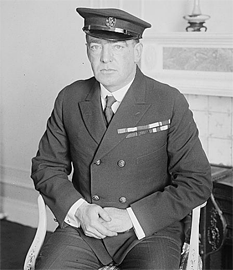
|
At home, Shackleton was not particularly happy. He tried various ventures to gain wealth but was unsuccessful, so his thoughts turned back to Antarctica. Shackleton began planning his next expedition there—he would be the first to cross the entire continent, a distance of 1,800 miles. He called it the Trans-Antarctic Expedition.
His first mammoth task was to fundraise the equivalent of $4 million to $5 million in today’s dollars to outfit and man two ships for the expedition. The crew of one ship, the Aurora, was to sail to the southern side of the continent and disembark a crew that would lay supplies in depots every 69 miles (1º of latitude) for the last half of Shackleton’s expedition. The other, the Endurance, was to carry Shackleton and his crew to the north side to begin their trek. Although he and his men never landed there, this was the start of the most heroic acts of Shackleton’s life.
|
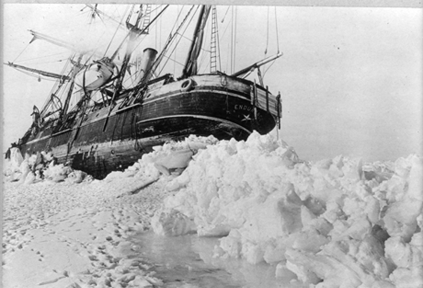
|
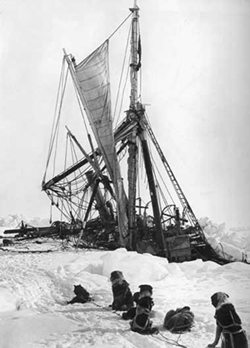
|
|
Endurance trapped in the ice.
|
Sinking of the Endurance.
|
The Trans-Antarctic Expedition never began its 1,800-mile journey because the Endurance became frozen in sea ice in January of 1915. The ship and men were trapped there (although the ice did drift slowly) for nine months until October when the ice finally crushed a hole in the ship. Shackleton ordered the crew to transfer their supplies from the ship to the ice. Taking on water, the Endurance finally sank about a month later in November. The expedition included a photographer, Hugh Robert Mill, and he documented the imprisonment of the ship in the ice and its sinking. (Several more of Mill’s photos can be seen at www.antiquingmagazine.com.)
Shackleton’s crew was stranded on a slowly moving ice flow until April when it broke apart, which forced them—and gave them the opportunity—to man three lifeboats. They had tried twice to hike over the ice to safety, but because of the rugged icescape and pulling sleds with supplies, they barely made a total of ten miles.
|
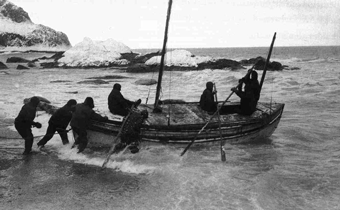
|
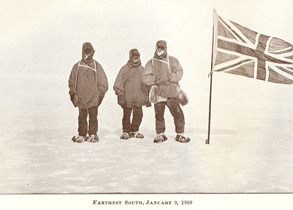
|
|
Shackleton’s lifeboat launching from Elephant Island.
|
Unable to reach the South Pole, Shackleton took this photo on Jan. 9, 1909 of (l-r) Jameson Adams, Frank Wild and Eric Marshall after the Union Jack was planted at their southernmost position.
|
In the open lifeboats in sub-zero weather over five days, they sailed more than 300 miles through ice-strewn waters to the uninhabited and mostly barren Elephant Island. With few supplies, Shackleton selected five men to sail with him in one lifeboat to a whaling station on South Georgia Island in the south Atlantic, more than 800 miles away over open water. They did so in about two weeks, enduring a storm that sank a steamer ship elsewhere.
Nothing about this expedition was easy for Shackleton and his crew. They landed on the opposite side of the island from the whaling station. Rather than risk their lives again in the rough seas, Shackleton and two crewmen walked 32 miles in a day and a half cross country to the station. From there, they secured help in rescuing the rest of the crew on Elephant Island—but it still took four and one half months to do so due again to sea ice.
No lives were lost on this part of the expedition; however, the crewmembers of the Aurora were not so fortunate. Sailing from Australia after being fitted with supplies, the crew knew nothing of Shackleton’s predicament. They went on and completed their task of depositing supplies despite the unrelenting cold and the lack of cold-weather experience of some of the men. Tragically, three men lost their lives, including their leader, Captain Aeneas Mackintosh. He and another man were never found after they left camp to trek to another point. The tracks of their footsteps ended at a crack in the ice.
The rest of this crew also had to be rescued when sea ice blocked the harbor where they landed.
In considering the overwhelming hardships that Shackleton overcame during about three years, the Trans-Antarctic Expedition would have been more aptly named after his, the Endurance.
After his return, Shackleton wrote South: The story of Shackleton's 1914–17 expedition, and he also lectured about the expedition. After World War I, Shackleton again planned another expedition of exploration, but this time, it was to the Arctic. For some reason, plans changed, and the Antarctic was again the goal.
On the way, Shackleton suffered a heart attack, and he died a few days later on Jan. 5, 1922 on South Georgia, the same island where he secured rescue for the men of his crew. It is fitting that he is buried there.
Ernest Shackleton was always a courageous explorer and a respected leader, even though his expeditions were not always as successful as he hoped. He was of the last generation of intrepid world explorers who now reside in the dim halls of history, waiting until something simple—like a cracker—brings their exploits and bravery again to the light of modern day.
Ted Carlton correctly identified Ernest Shackleton last month but was not credited for his expertise in identifying famous people. My apologies.
In December, new photos taken of Shackelton’s ship, Endurance, were featured on www.Smithsonianmag.com. Ninety photos in the archives of the Royal Geographic Society have been digitized and will be on display in London. One photos shows Endurance with raised sails when the crew thought they could free the ship from the ice.
---------------------------------
Credit:
Ernest Shackleton, South: The story of Shackleton's 1914–17 expedition, publ. 1919.
Caroline Alexander, The Endurance: Shackleton's legendary Antarctic expedition, published 1985.
Learn
about more Famous People
|